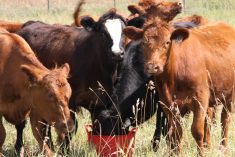BEECHY, Sask.-Bandit’s chocolate eyes scan the rolling hills for cattle, as muscles tense beneath the mottled hair on his neck and back.
The Blue Heeler-Border Collie is as important as a horse to community pasture manager Harold Gates, who oversees 2,200 cattle spread across 27,000 acres near Beechy.
It is one of 54 community pastures operated by the Saskatchewan Pastures Program, covering 800,000 acres across the province.
In less time than it takes to saddle a horse, Bandit shows his instinctive herding by moving dozens of animals from one end of the native grasslands and rolling hillsides to another and then back again.
Read Also

Animal protection delivery to change in Saskatchewan
The Saskatchewan government is looking for a new agency to handle animal welfare after Animal Protection Services of Saskatchewan decided not to renew its contract next year.
Tongue lolling, he settles into the spear grasses near Gates and his sleepy-eyed horse to await the next command.
Gates spends most days of the week here checking animals, fences and water sources, getting help from Bandit but also from his wife Linda and rider Wade Rempel.
It’s familiar territory for Gates, who is the third generation of his family to live in these hills.
He operates his own cow-calf operation and has managed pastures since 1971. His son serves as a rider at the Matador community pasture.
“It kind of runs in your blood, it’s what you do,” Linda said of the family’s attachment to ranch life.
Winter offers a few months’ reprieve from the 24-7 work of pasture management.
“In winter, we manage our own livestock and recharge for the next year,” said Gates, 60, whose interests include rodeoing, travel and his growing brood of grandchildren.
The couple takes a keen interest in the flora and fauna that surrounds them, the tiger lilies that bloom each summer and the black-eyed susans lining the trail.
“Some people think it’s great and some think it’s wasteland,” he said. “I would not go to live anywhere else.”
The community pasture preserves the land in its natural state while offering a valuable grazing resource to cattle producers, he said.
In recent years, the Gates built their own home after living in the pasture’s living quarters for 30 years.
Gates’ eyes are bloodshot this day from late nights baling hay on his home farm. It provides a base income for him because the pasture job runs only seven months.
“This is real good off-farm income, but not a good full-time living,” he said.
About 35 producers either trail or truck their animals here for their stay from May to October every year.
“The demand is way beyond what we can supply,” he said of pasture space.
Producers pay the pastures program 38 cents a day for each cow they bring, which works out to about $30 per cow and $18 per calf for the grazing season. They also help pay some of the land taxes.
Gates said costs are much the same as they would be on home ranches, but noted many ranches cannot supply enough grass for their cattle. This year, pasture conditions remained excellent well into summer.
When not on the range, Gates spends countless hours keeping records updated, filing reports and managing billing to producers.
On this overcast day, he began at around
6 a.m., with breakfast and “a lot of coffee” before heading out to the check the herd.
There are few surprises found along the rugged trail that cuts through the pasture. Bulls chew contentedly on grass up to their bellies while cows dot the nearby hillside.
The previous day Gates had to load up and treat a bull he found injured.
“It’s dangerous and you don’t want to make no mistakes,” he said.
Gates once broke his wrist loading cattle, and his wife suffered a snapped collarbone after being pinned by a horse.
Gates said their job is about “doing due diligence” as they ride many kilometres on their horses looking for foot rot, pneumonia, displaced hips, pink eye, droopy ears and snotty noses.
“We watch for everything,” he said of the $2 million worth of livestock they are entrusted with this year.
“We’re just babysitting the cows. We just don’t let anything bad happen to them.”














